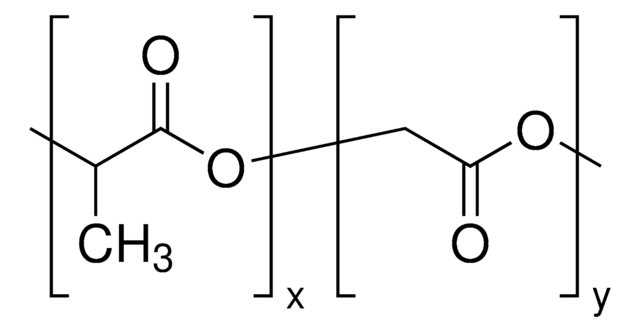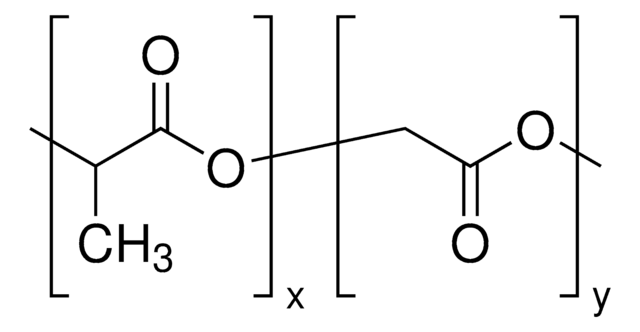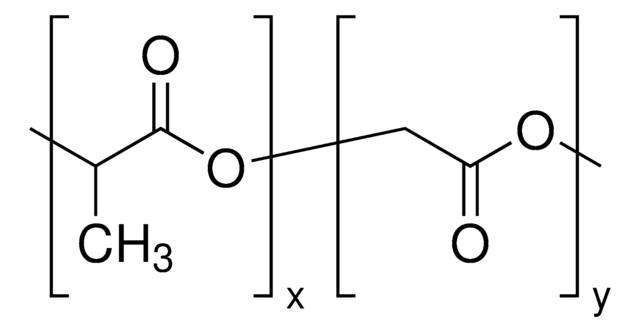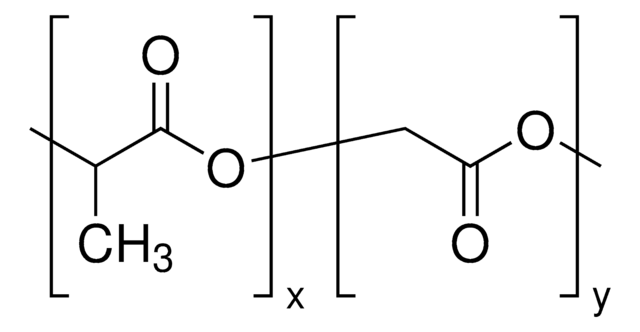739960
Resomer® RG 505, Poly(D,L-lactide-co-glycolide)
ester terminated, Mw 54,000-69,000
Synonym(s):
PLGA
Sign Into View Organizational & Contract Pricing
All Photos(1)
About This Item
Linear Formula:
[C3H4O2]x[C2H2O2]y
CAS Number:
MDL number:
UNSPSC Code:
12162002
NACRES:
NA.23
Recommended Products
form
amorphous
feed ratio
lactide:glycolide 50:50
mol wt
Mw 54,000-69,000
degradation timeframe
<3 months
viscosity
0.61-0.74 dL/g, 0.1 % (w/v) in chloroform(25 °C, Ubbelohde) (size 0c glass capillary viscometer)
transition temp
Tg 48-52 °C
storage temp.
2-8°C
SMILES string
O2C(C(=O)OC(C2=O)C)C.O1CC(=O)OCC1=O
InChI
1S/C6H8O4.C4H4O4/c1-3-5(7)10-4(2)6(8)9-3;5-3-1-7-4(6)2-8-3/h3-4H,1-2H3;1-2H2
InChI key
LCSKNASZPVZHEG-UHFFFAOYSA-N
Related Categories
General description
Poly(lactide-co-glycolide)(PLGA) is a biodegradable polymer used in the preparation of polymericmicrospheres. These polymers degrade in vivo by hydrolysis of their esterbackbone into non-toxic products, which are excreted by the kidneys oreliminated as CO2 and water through biochemical pathways. PLGAmicrospheres have been widely used to encapsulate drug molecules and have beenused as long-acting, sustained-release pharmaceutical formulations.
Application
Poly(lactide-co-glycolide)(PLGA) can be used to fabricate sustained-release drug delivery systems, for example, it can be used to encapsulate the anti-inflammatory lipophilic drug atorvastatin.
Legal Information
Product of Evonik
RESOMER is a registered trademark of Evonik Rohm GmbH
Storage Class Code
11 - Combustible Solids
WGK
WGK 3
Flash Point(F)
Not applicable
Flash Point(C)
Not applicable
Choose from one of the most recent versions:
Already Own This Product?
Find documentation for the products that you have recently purchased in the Document Library.
Customers Also Viewed
Vanna Sanna et al.
International journal of nanomedicine, 7, 5501-5516 (2012-10-25)
Resveratrol, like other natural polyphenols, is an extremely photosensitive compound with low chemical stability, which limits the therapeutic application of its beneficial effects. The development of innovative formulation strategies, able to overcome physicochemical and pharmacokinetic limitations of this compound, may
Shu-Chun Chuang et al.
Parasites & vectors, 6, 34-34 (2013-02-13)
Current development efforts of subunit vaccines against Toxoplasma gondii, the etiological agent of toxoplasmosis, have been focused mainly on tachyzoite surface antigen 1 (SAG1). Since microparticles made from poly (lactide-co-glycolide) (PLG) polymers have been developed as safe, potent adjuvants or
Mani Gajendiran et al.
Colloids and surfaces. B, Biointerfaces, 104, 107-115 (2013-01-10)
A series of biodegradable low molecular weight PLGA-PEG-PLGA tri-block copolymers have been synthesized in powder form. The anti-tuberculosis drug Isoniazid (INH) loaded polymeric core-shell nanoparticles (CSNPs) have been prepared by sonication followed by water-in-oil-in-water (w/o/w) double emulsification technique. The nanoparticles
Rongcai Liang et al.
International journal of pharmaceutics, 454(1), 344-353 (2013-07-23)
Peptide or protein degradation often occurs when water flows into the dosage form. The aim of this study was to investigate the effect of water on exenatide acylation in poly(lactide-co-glycolide) (PLGA) microspheres. Exenatide-loaded PLGA microspheres were incubated at different relative
Maria Kirzhner et al.
Ophthalmology, 120(6), 1300-1304 (2013-02-13)
To compare wrapped and polymer-coated hydroxyapatite implants in children undergoing primary enucleation with no adjuvant therapies. Retrospective, interventional cohort study. All children undergoing primary enucleation without adjuvant therapies between 1999 and 2009 at a tertiary pediatric cancer hospital. Review and
Our team of scientists has experience in all areas of research including Life Science, Material Science, Chemical Synthesis, Chromatography, Analytical and many others.
Contact Technical Service








